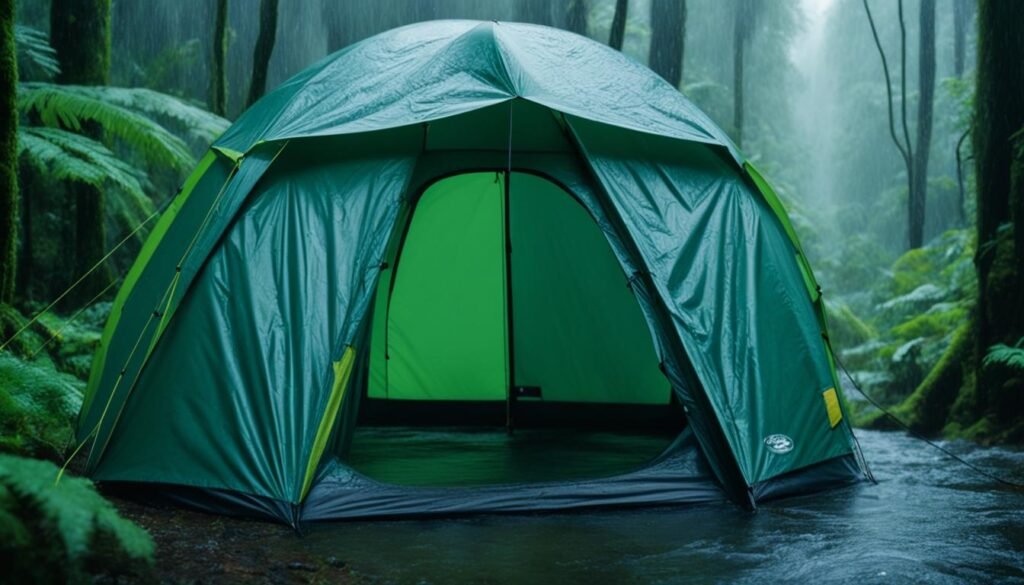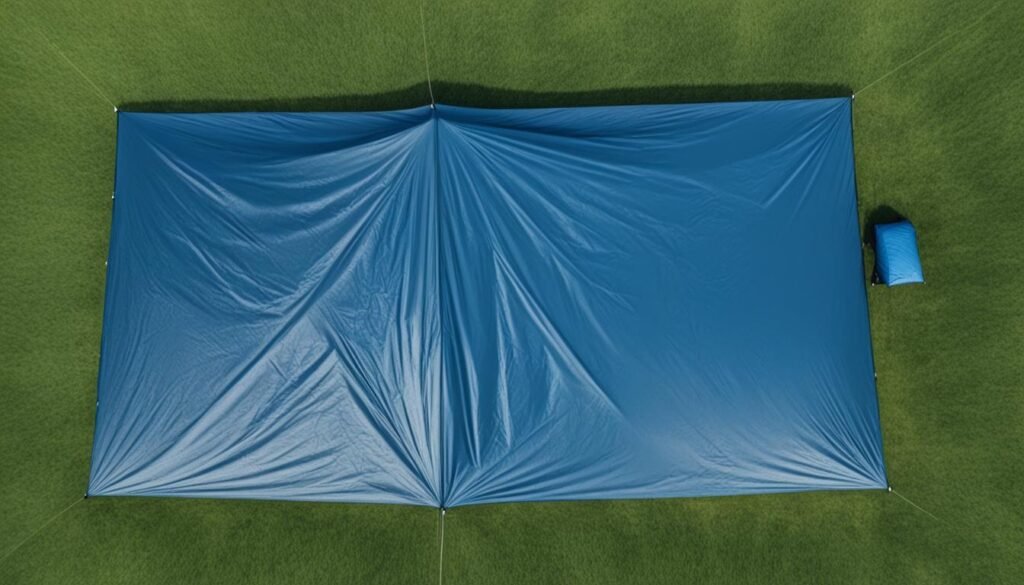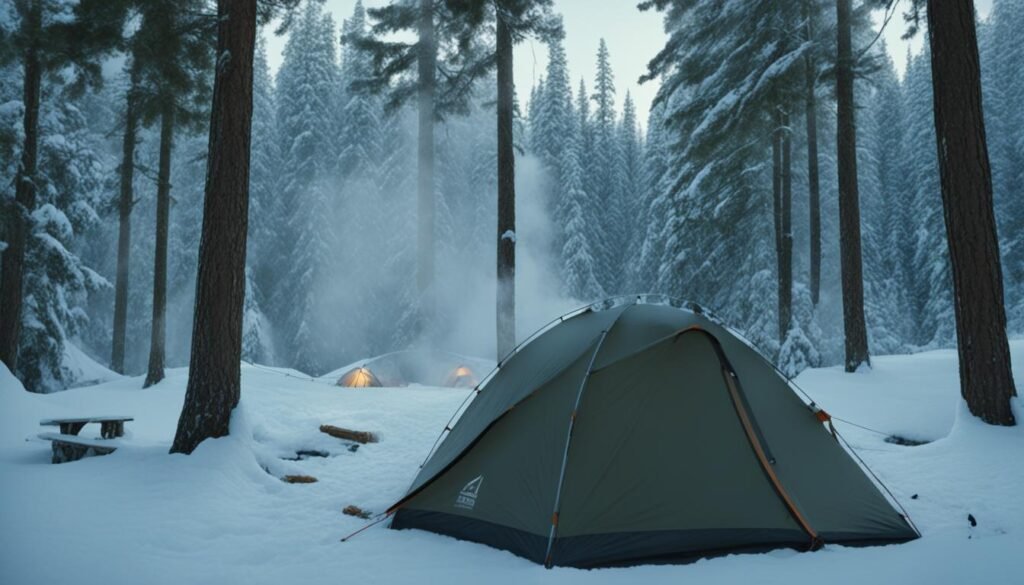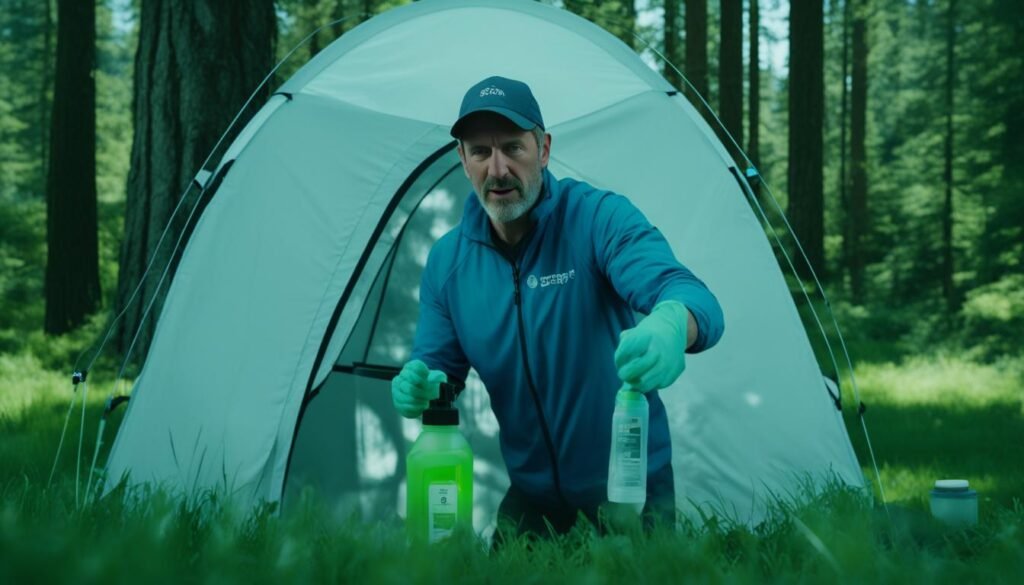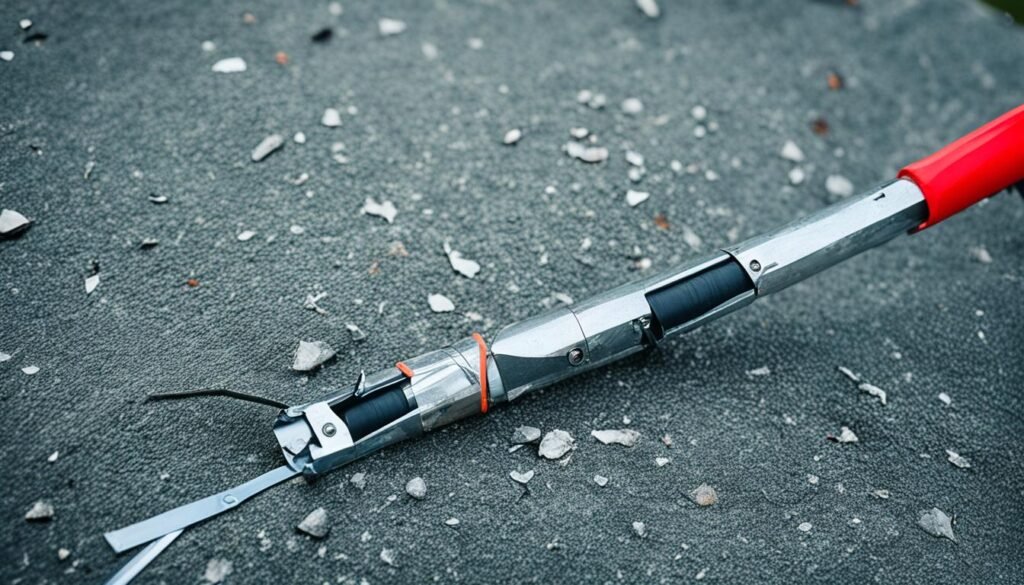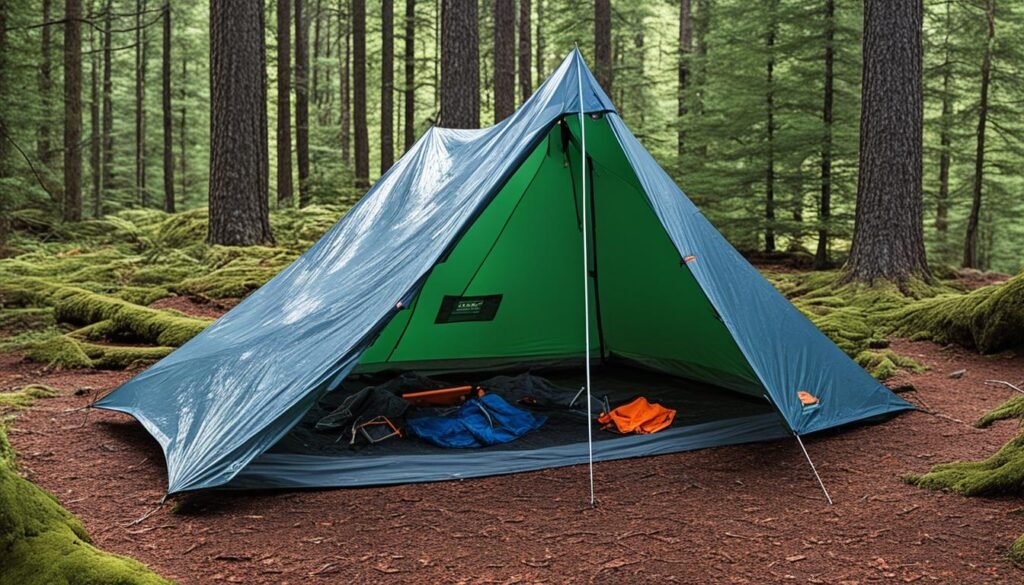As an outdoor enthusiast myself, I understand the importance of having a reliable and waterproof shelter when braving the elements. I will provide you with expert tips, methods, and product recommendations to help you keep your tent waterproof and in top condition.
Whether you’re a seasoned camper or just starting out, knowing how to waterproof your tent is essential knowledge. It not only protects you from unexpected rain showers but also ensures the longevity of your tent by preventing damage from moisture and leaks.
In this guide, we will cover everything from tent seam sealing and rainfly treatment to tent base waterproofing and DIY methods. With the right techniques and products, you can confidently venture into the great outdoors, knowing that your tent will keep you dry, comfortable, and ready for any weather conditions.
Key Takeaways:
- Proper tent waterproofing is essential for a dry and comfortable camping experience.
- Regular maintenance and re-waterproofing can prevent leaks and extend the lifespan of your tent.
- Tents can lose their waterproofness over time due to wear and tear, UV damage, and dirt accumulation.
- Sealing tent seams, treating the rainfly, and waterproofing the tent base are important steps in the waterproofing process.
- Follow best practices such as selecting an elevated campsite, using a groundcloth, and packing your tent dry to enhance waterproofing.
The Importance of Waterproofing Your Tent
Your tent is one of the most crucial pieces of gear for your comfort and safety while camping. However, without proper maintenance, the waterproof coating on tents can wear out over time, leading to leaks and discomfort during your outdoor adventures. This is why waterproofing your tent is of utmost importance.
By investing time in tent waterproofing, you can prevent leaks and ensure a dry and cozy camping experience. Waterproofing not only keeps you dry but also helps maintain the lifespan of your tent, saving you money in the long run.
Regular care and maintenance, including tent waterproofing, are essential to keep your tent in optimal condition. By taking the necessary steps to prevent leaks and maintain the waterproof coating, you can enjoy camping trips without the worry of getting wet or uncomfortable inside your tent.
Remember, prevention is key. By waterproofing your tent, you can prevent the annoying, and sometimes dangerous, leaks that can occur during unexpected rain showers. Don’t let a rainy day ruin your camping experience; take the time to waterproof your tent and stay dry in any weather.
“Waterproofing your tent is essential to prevent leaks and ensure a dry and cozy camping experience.”
So, let’s dive into the benefits of tent waterproofing, the importance of tent maintenance, and how you can prevent leaks in your tent for a hassle-free camping experience.
Benefits of Tent Waterproofing
There are several benefits to waterproofing your tent:
- Stay dry and comfortable: Waterproofing your tent keeps you dry, preventing moisture from seeping through the fabric and causing discomfort during your camping trips.
- Protect your gear: A waterproof tent safeguards your valuable camping gear from water damage, ensuring your equipment stays in top condition.
- Extend tent lifespan: Regular tent maintenance and waterproofing can help extend the lifespan of your tent, allowing you to enjoy outdoor adventures for years to come.
By taking the time to waterproof your tent, you’ll reap these benefits and enjoy a worry-free camping experience.
When to Re-Waterproof Your Tent
Not all tents require annual waterproofing if they are properly stored and cleaned. However, there are certain signs that indicate your tent may need re-waterproofing. Assessing the condition of your tent and identifying any leaks or wear and tear will help determine if it’s time to re-waterproof.
Signs Your Tent Needs Waterproofing
- Water collecting underneath the tent: If you notice pools of water forming beneath your tent during rainfall, it may indicate that the waterproof coating has worn off or that the tent material has become saturated.
- Improper staking causing water to enter the tent: If water seeps through the seams or enters the tent due to improperly staked guylines or flaps, it’s a sign that the tent’s waterproofing needs attention.
- Camping in dusty or rocky areas: Dust and abrasive particles can cause damage to the waterproof coating, compromising its effectiveness. Additionally, rocky terrains may puncture the tent fabric, leading to potential leaks.
Regularly inspecting your tent for these signs and performing routine maintenance will ensure that your tent remains waterproof and ready for your outdoor adventures.
| Signs Your Tent Needs Waterproofing | What to Look For |
|---|---|
| Water collecting underneath the tent | Pools of water forming during rainfall |
| Improper staking causing water to enter the tent | Water seeping through seams or entering the tent due to improperly staked guylines or flaps |
| Camping in dusty or rocky areas | Dust and abrasive particles damaging the waterproof coating or rocky terrains causing punctures |
Assessing the condition of your tent and identifying any leaks or wear and tear will help determine if it’s time to re-waterproof.
Always prioritize tent maintenance to ensure optimal performance and longevity. By taking prompt action when signs of waterproofing issues arise, you can maintain a dry and comfortable camping experience.
Waterproofing Tent Seams
Tent seams are often the weak points where water can seep into your tent, compromising its waterproofness. Over time, factory-taped seams may degrade, leading to potential leaks. To ensure a watertight shelter, it is essential to properly seal tent seams.
Here is a step-by-step guide on how to seal tent seams:
- Clean the seams: Start by thoroughly cleaning the tent seams. Use a mild soap, warm water, and a soft brush to remove any dirt, grime, or old sealant. Allow the seams to dry completely before proceeding.
- Remove peeling tape: If you notice any peeling or deteriorating seam tape, carefully remove it using a seam ripper or a small pair of scissors. Make sure to remove all remnants of the tape without damaging the fabric.
- Apply silicone sealant: Choose a purpose-made silicone sealant suitable for tent seams, such as Gear Aid Seam Grip or McNett Sil Net. Apply a thin and even layer of the sealant along the length of each seam using a popsicle stick or a small brush. Pay extra attention to major stress points, such as corners and pole anchor points.
- Spread the sealant: Use the popsicle stick or brush to spread the sealant evenly, ensuring it covers the entire seam. This will help create a robust barrier against water intrusion. Avoid applying too much sealant, as it may create clumps or affect the flexibility of the fabric.
- Cure the sealant: Allow the sealant to cure for approximately six hours or follow the manufacturer’s instructions. It’s crucial to give the sealant enough time to dry and form a durable bond with the tent fabric.
Sealing tent seams is an important step in maintaining the waterproofness of your tent. By taking the time to properly seal the seams, you can ensure a dry and comfortable camping experience, even in wet conditions.
Remember, it’s recommended to seal all seams at once, even if only one seam appears to be compromised. This proactive approach helps prevent potential future leaks as other seams may start delaminating. Regularly inspect and reseal tent seams as part of your tent maintenance routine to keep your shelter watertight and ready for your outdoor adventures.
Waterproofing the Tent Fly
The tent fly is a crucial component of your tent that protects it from rain and moisture. To ensure optimal protection, it’s essential to properly waterproof the tent fly. Here’s how you can do it:
Inspect and Repair
Start by carefully inspecting the tent fly for any small rips or tears. If you find any, patch them up using waterproof tape. This will prevent water from seeping through these areas and keep your tent dry.
Choose the Right Product
To effectively waterproof the tent fly, it’s recommended to use high-quality waterproofing products specifically designed for tent flies. Two popular options are Nikwax TX.Direct, which is suitable for waterproof-breathable materials, and Nikwax SolarProof, designed for flies and tarps. Both products provide excellent waterproofing and UV protection.
Apply the Waterproofing Spray
Before applying the waterproofing spray, make sure to thoroughly clean the tent fly. Follow the product directions to apply the spray evenly, ensuring complete coverage of the fabric. Use a clean cloth to wipe off any excess spray.
Allow for Drying Time
After applying the waterproofing spray, allow the tent fly to dry completely before using it. This will ensure that the product effectively bonds with the fabric and provides long-lasting waterproof protection.
By properly waterproofing the tent fly, you can enjoy a dry and comfortable camping experience, even in wet weather conditions. Remember to inspect and repair any damage, choose the right product, apply the waterproofing spray evenly, and allow for adequate drying time.
Waterproofing the Tent Base or Ground Cloth
The base of the tent body and the ground cloth are in constant contact with the ground, making them prone to wear and tear. It is essential to ensure that both these components are adequately waterproofed to avoid moisture seepage into the tent. Here are some steps to effectively waterproof the tent base and ground cloth:
1. Inspect for tears and damages
Before waterproofing, carefully examine the tent base and ground cloth for any tears or damages. Any holes or gaps can compromise the effectiveness of the waterproofing process. Use waterproof tape to patch any identified areas of concern. This step will help ensure a solid foundation for waterproofing.
2. Choose the right waterproofing spray
Select a high-quality waterproofing spray specifically designed for tent fabric. Look for products that offer long-lasting waterproof protection and are safe to use on various types of tent materials. Brands like Nikwax and Gear Aid have reliable tent waterproofing sprays that provide excellent results.
3. Apply the waterproofing spray
Follow the instructions on the waterproofing spray carefully. Spread out the tent base and ground cloth in a clean, well-ventilated area. Holding the spray can approximately 6-8 inches away, spray an even and generous layer of the waterproofing spray onto the entire fabric surface. Ensure that all areas, including edges and corners, are adequately coated.
4. Let it dry
Allow the tent base and ground cloth to dry completely before packing them away. It is best to leave them to dry with the fly off, preferably in the shade or a well-ventilated space. This step ensures that the waterproofing spray sets properly, enhancing its effectiveness once the tent is set up for use.
Properly waterproofing the tent base and ground cloth is crucial for maintaining a dry and comfortable camping experience. By addressing wear and tear and using a reliable waterproofing spray, you can ensure that your tent is well-prepared to withstand wet and damp conditions, allowing you to enjoy your outdoor adventures with peace of mind.
| Benefits | Considerations |
|---|---|
|
|
The Benefits of Waterproofing Your Tent
When it comes to camping, a waterproof tent is a game-changer. It offers numerous advantages that enhance your outdoor experience and protect your gear. Let’s explore the benefits of tent waterproofing and why it’s essential to invest in this crucial step.
Advantage #1: A Dry and Comfortable Camping Experience
There’s nothing worse than waking up in a wet tent after a night of heavy rain. Waterproofing your tent ensures that you stay dry and comfortable throughout your camping trip, regardless of the weather conditions. By creating a barrier between you and the elements, you can enjoy a good night’s sleep and wake up refreshed to fully embrace the day’s adventures.
Advantage #2: Protection Against Water Damage
A waterproof tent not only keeps you dry but also safeguards your camping gear from water damage. Moisture can seep into your belongings, leading to mold, mildew, and irreparable damage. By waterproofing your tent, you create a protective shield that prevents water from entering, keeping your gear safe and extending its lifespan.
Advantage #3: Extended Tent Lifespan
Investing in tent waterproofing not only benefits your immediate camping trips but also pays off in the long run. By maintaining the waterproof coating and preventing leaks, you can significantly extend the lifespan of your tent. Regular maintenance, including seam sealing and waterproofing treatments, helps preserve the fabric and ensures that your tent remains durable and reliable for many years to come.
Overall, waterproofing your tent is a smart decision that provides multiple advantages. It keeps you dry, protects your gear, and increases the longevity of your tent. By preventing leaks and maintaining the waterproof coating, you can enjoy worry-free camping adventures regardless of the weather conditions.
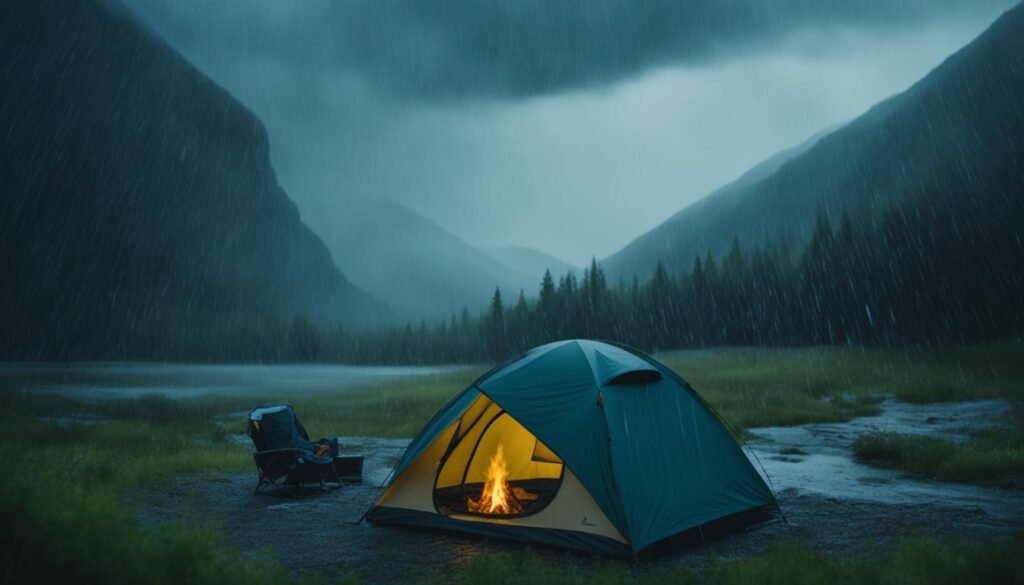
Understanding Waterproof Fabric
Waterproof fabric is an essential component of outdoor gear, ranging from tents and jackets to boots and backpacks. It is designed to keep you dry and comfortable in wet conditions by preventing water from penetrating the material. In this section, I will explain how waterproof fabric works, the technology behind it, and the different ratings used to measure its effectiveness.
Waterproof fabric consists of multiple layers that work together to repel water while allowing moisture to escape. The outer layer is made of a durable fabric that has been treated to resist water. This surface layer prevents water droplets from being absorbed into the fabric, causing them to bead up and roll off.
The coated membrane is the key component responsible for making the fabric waterproof. This membrane is typically made of a thin layer of polyurethane (PU) or ePTFE (expanded polytetrafluoroethylene) that has microscopic pores. These pores are large enough to allow water vapors, such as sweat and condensation, to escape but small enough to prevent water droplets from entering.
To further enhance the waterproofing capabilities, a Durable Water Repellent (DWR) layer is applied to the fabric. This layer is a chemical treatment that causes water to bead up and roll off the surface, preventing it from saturating the fabric. The DWR treatment needs to be periodically reapplied, as it can wear off over time with use and exposure to the elements.
The effectiveness of waterproof fabric is measured using a waterproof rating system called hydrostatic head, which indicates the fabric’s ability to withstand water pressure without leaking. The rating is expressed in millimeters (mm), with higher numbers indicating a higher level of waterproofness. For example, a fabric with a rating of 10,000mm can withstand the pressure of a 10-meter column of water before leaking.
It’s important to note that while higher waterproof ratings provide better protection against heavy rain and prolonged exposure to water, they may also reduce breathability. Fabrics with higher ratings may trap more heat and moisture inside, leading to potential discomfort. Therefore, it’s crucial to strike a balance between waterproofness and breathability based on the intended use and environmental conditions.
| Waterproof Rating (mm) | Water Resistance | Recommended Use |
|---|---|---|
| 0 – 5,000 | Not recommended for prolonged exposure to rain | Light showers, minimal water contact |
| 5,000 – 10,000 | Moderate water resistance | Light to moderate rain, short durations |
| 10,000 – 15,000 | High water resistance | Steady rain, extended periods |
| 15,000+ | Excellent water resistance | Heavy rain, prolonged exposure |
“Understanding the technology behind waterproof fabric is crucial for selecting the right outdoor gear that meets your needs. By considering the waterproof rating and breathability, you can ensure optimal performance and comfort in various weather conditions.”
What Causes a Tent to Lose Waterproofness
Over time, tents can lose their waterproofness due to a variety of factors. Understanding these factors can help you better maintain and protect your tent for optimal performance. The following are some common reasons why tents may lose their waterproof qualities:
1. Accumulation of Dirt and Oil
The presence of dirt and oil particles can significantly impact the waterproofness of your tent. When these substances get ground into the fabric, they can compromise the effectiveness of the waterproof coating. Regular cleaning and proper storage can help minimize the buildup of dirt and oil, preserving the waterproof qualities of your tent.
2. UV Damage from the Sun
Exposure to sunlight, particularly ultraviolet (UV) rays, can cause the waterproof coating on tents to degrade over time. The intense UV radiation breaks down the chemicals in the coating, leading to reduced water resistance. Whenever possible, avoid prolonged exposure to direct sunlight and consider using a UV protectant spray specifically designed for outdoor fabrics.
3. Wear and Tear on the Waterproof Coating
The waterproof coating on tents can wear out or become damaged due to regular use and exposure to the elements. Abrasion from rough surfaces, such as rocks or branches, can cause the coating to peel or chip away, compromising its effectiveness. Additionally, the repetitive folding and unfolding of the tent can strain the coating, leading to degradation over time.
4. Deterioration of Tent Seams
Tent seams are critical areas vulnerable to water leaks. Over time, the seam tape or sealing material can deteriorate, resulting in compromised waterproofness. Factors such as humidity, temperature fluctuations, and movement during setup can accelerate the degradation of tent seams. Regular inspection and maintenance of your tent’s seams can help identify any issues and prevent leaks.
Regular use, exposure to the elements, and improper maintenance can all contribute to the loss of waterproofness in tents. By understanding these factors, you can take proactive measures to protect your tent and ensure its longevity. Regular cleaning, proper storage, and timely repairs will help maintain the waterproof qualities of your tent, ensuring a dry and comfortable camping experience.
Note: The image above illustrates the various factors that can affect the waterproofing of tents.
Step-by-Step Guide to Waterproofing a Tent
Waterproofing your tent is an essential step in ensuring a dry and comfortable camping experience. Follow this easy step-by-step guide to effectively waterproof your tent and protect yourself from unexpected rain showers.
1. Find and Patch Leaks
Start by inspecting your tent for any leaks. Look for areas where water may seep in, such as seams, corners, and zippers. Use waterproof tape to patch any holes or tears to ensure a watertight seal.
2. Thoroughly Clean the Tent
Before waterproofing, make sure your tent is clean and free from dirt, debris, and any previous coatings. Use a mild soap or tent cleaner and a soft brush to gently scrub the tent fabric. Rinse thoroughly and allow it to dry completely.
3. Apply Waterproof Sealant to Seams
To reinforce the waterproofing of your tent seams, apply a waterproof sealant. Use a brush or sponge to evenly distribute the sealant along the seams, ensuring full coverage. Pay close attention to areas that are prone to leakage, such as the rainfly attachment points, corners, and footprints.
4. Treat the Tent Fly with Waterproofing Spray
The tent fly is the outer layer that protects your tent from rain. To waterproof it, use a quality waterproofing spray designed for tent fabrics. Apply the spray evenly on both sides of the fly, focusing on the seams and high-stress areas. Follow the product instructions for drying time.
5. Waterproof the Tent Base
The tent base or ground cloth is in constant contact with the ground and is susceptible to wear and tear. To waterproof it, use a waterproofing spray or wash specifically designed for tent fabrics. Apply the product evenly on the base and allow it to dry completely before packing.
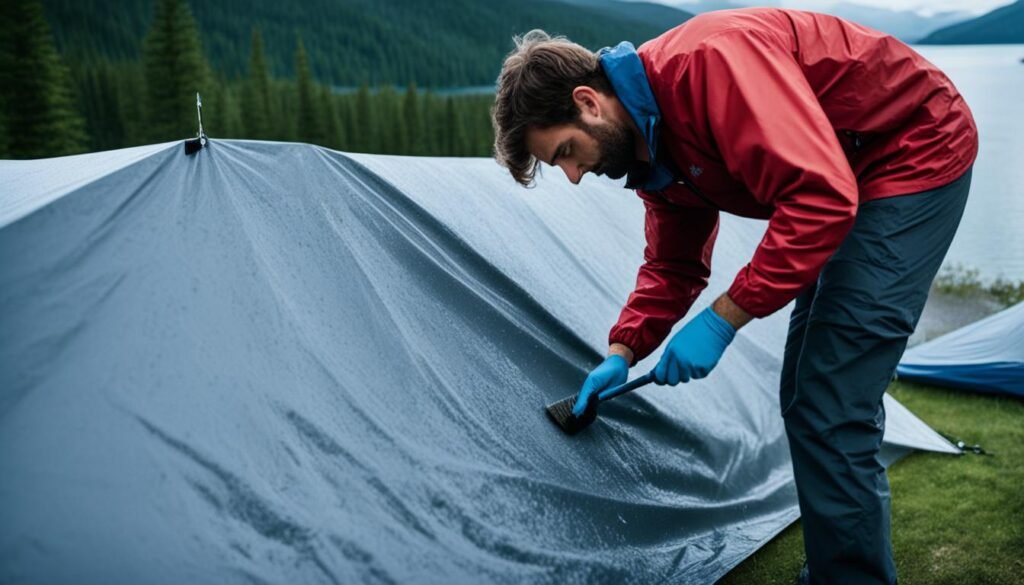
6. Regular Maintenance
Regular maintenance is crucial to keep your tent waterproof. After each camping trip, inspect your tent for any damage and repair it as needed. Check the seams, zippers, and fabric for signs of wear and tear. Additionally, reapply waterproofing treatments as recommended by the product instructions.
By following this step-by-step guide and performing regular tent maintenance, you can ensure that your tent remains waterproof and ready for any camping adventure.
Tips for Tent Waterproofing
Along with the waterproofing process, there are additional tips you can follow to ensure maximum waterproofing effectiveness.
- Place a ground cloth under your tent: A ground cloth acts as an extra barrier between your tent and the wet ground, preventing moisture from seeping through.
- Set up your tent on higher ground: Choosing a campsite on higher ground helps prevent water pooling around your tent during rainfall, reducing the risk of leaks.
- Use a tarp inside the tent: Placing a tarp beneath your sleeping area inside the tent provides an added layer of protection against moisture and condensation.
- Pack your tent dry: Before storing your tent, ensure that it is completely dry to prevent the growth of mold and mildew. This will also help maintain the integrity of the waterproof coatings.
- Ventilate your tent: Proper ventilation allows for airflow within the tent, reducing condensation and keeping the interior dry.
- Pack rain gear: Always carry rain gear, such as waterproof jackets and pants, to protect yourself from unexpected showers while camping.
By implementing these tent waterproofing tips and best practices, you can enhance the waterproofing effectiveness of your tent and enjoy a dry camping experience.
Expert Tip:
Remember that regular tent maintenance is essential for ensuring its longevity and waterproofing capabilities. Inspect your tent before and after each camping trip, keeping an eye out for any signs of wear and tear. Repair any damage promptly to prevent further issues.
Waterproofing a Tent Floor
Properly waterproofing the floor of your tent is essential to protect yourself and your gear from groundwater seepage. By following a few simple steps, you can ensure a dry and comfortable camping experience.
Choose the Right Tent Floor Sealer
To effectively waterproof your tent floor, it’s important to select a high-quality tent sealer specifically designed for this purpose. Look for products that offer reliable waterproofing and durability.
Read and Follow Instructions
Before applying the tent floor sealer, carefully read and follow the manufacturer’s instructions. This will ensure that you apply the product correctly and maximize its effectiveness.
Apply Multiple Coats
For optimal waterproofing, it’s recommended to apply multiple coats of the tent floor sealer. This will create a strong barrier against water penetration and enhance the overall waterproofing performance of your tent floor.
Pro Tip: Allow each coat to dry completely before applying the next one to ensure proper adherence and effectiveness.
Ensure the Tent is Dry
Prior to applying the tent floor sealer, make sure that your tent is completely dry. This will prevent moisture from becoming trapped between the fabric and the sealer, ensuring optimal waterproofing results.
Allow for Proper Drying Time
After applying the tent floor sealer, allow sufficient drying time as recommended by the product instructions. This will ensure that the sealer fully cures and bonds with the fabric, providing long-lasting waterproofing.
By following these steps and using the right products, you can effectively waterproof your tent floor and protect yourself from groundwater seepage. Don’t let wet ground ruin your camping experience; take the necessary precautions to keep your tent dry and comfortable.
Keep Your Tent Dry – Tips for Camping
In addition to waterproofing your tent, there are several tips you can follow to keep your tent dry while camping. By implementing these strategies, you can enhance the effectiveness of your tent’s waterproofing and ensure a dry and comfortable camping experience.
Selecting the Right Campsite
One of the key factors in keeping your tent dry is selecting the right campsite. Choose a location on higher ground to avoid pooling water and potential flooding. Avoid valleys or areas where water may gather during rainfall.
Using a Groundcloth or Tarp
Using a groundcloth or tarp underneath your tent can provide an additional layer of protection against moisture. It acts as a barrier between the tent floor and the wet ground, preventing water from seeping through and keeping your tent dry.
Ensuring Proper Tent Setup and Rain Fly Coverage
Proper tent setup is crucial for keeping your tent dry. Ensure that all tent seams are properly sealed to prevent water from entering through the stitching. Additionally, make sure that the rain fly covers the entire tent, including the mesh windows, to protect against rain and moisture.
Carrying Waterproof Gear
Carrying waterproof gear such as rain jackets and waterproof stuff sacks is essential to keep both yourself and your belongings dry. Invest in high-quality waterproof gear that will protect you from the elements and ensure a comfortable camping experience.
“A little rain doesn’t have to dampen your camping adventure. With the right equipment and preparation, you can stay dry and enjoy the great outdoors.”
Remember, even with the best waterproofing, it’s important to take preventive measures to keep your tent dry. By following these tips and taking care of your gear, you can have a fantastic camping experience, rain or shine.
| Tips for Keeping Your Tent Dry |
|---|
| Select a campsite on higher ground |
| Use a groundcloth or tarp underneath your tent |
| Ensure proper tent setup and rain fly coverage |
| Carry waterproof gear such as rain jackets and waterproof stuff sacks |
Conclusion
Ensuring your tent is properly waterproofed is crucial for a comfortable and dry camping experience. By following the step-by-step process outlined in this guide and implementing the tips provided, you can effectively waterproof your tent and enhance its longevity.
Regular maintenance, such as seam sealing and treating the tent fly and base, will play a significant role in preventing leaks and extending the lifespan of your tent. Take the time to inspect your tent regularly for wear and tear, and address any issues promptly.
Remember, always use high-quality waterproofing products and follow the manufacturer’s instructions for optimal results. Whether you’re embarking on a camping trip in the rain or expecting unexpected showers, a well-waterproofed tent will keep you dry and comfortable, allowing you to fully enjoy your outdoor adventures.
Are the Waterproofing Techniques for Tents and Prepping for Rain the Same?
When it comes to preparing for rain, waterproofing techniques for tents are essential. A proper tent setup for rain involves applying seam sealer, using a waterproofing spray, and ensuring the rainfly is taut. These techniques will help keep you dry and comfortable during your outdoor adventures.
FAQ
Why is waterproofing your tent important?
Waterproofing your tent is important to prevent leaks, keep you dry and comfortable during your outdoor adventures, protect your gear from water damage, and extend the lifespan of your tent.
When should I re-waterproof my tent?
You should re-waterproof your tent if you notice water collecting underneath it, experience leaks due to improper staking or camping in dusty or rocky areas, or if you see signs of wear and tear on the tent’s waterproof coating.
How do I seal tent seams?
Clean the tent seams, remove any peeling tape, and apply a thin layer of purpose-made silicone sealant along the length of the seam. Use a popsicle stick to spread it evenly. Let it cure for about six hours before using the tent.
What should I do to waterproof the tent fly?
Patch any small rips with waterproof tape and use a product like Nikwax TX.Direct or Nikwax SolarProof. Follow the product directions, apply the waterproofing spray evenly, wipe off excess, and allow it to dry before using the tent.
How can I waterproof the tent base or ground cloth?
Inspect for tears and patch them with waterproof tape. Use a waterproofing spray or wash specifically designed for tent fabric to treat the base. Allow the base to dry before packing it away.
What are the benefits of waterproofing a tent?
Waterproofing your tent ensures a dry and comfortable camping experience, protects your gear from water damage, and extends the lifespan of your tent.
How does waterproof fabric work?
Waterproof fabric is made up of layers, including an outer fabric, a coated membrane with microscopic holes for breathability, and a Durable Water Repellent (DWR) layer for added waterproof coating. The waterproof rating refers to its ability to withstand water pressure without leaking.
Why do tents lose their waterproofness?
Tents can lose their waterproofness over time due to dirt and oil particles, UV damage, wear and tear on the waterproof coating, and degradation of tent seams.
How do I waterproof a tent step-by-step?
Find and patch any leaks, clean the tent, seal the seams, treat the tent fly and base with waterproofing products, and allow for proper drying time between each step.
What tips can you give for tent waterproofing?
Some tips for tent waterproofing include using a ground cloth or tarp, setting up the tent on higher ground, ventilating the tent, packing it dry, and carrying waterproof gear.
How do I waterproof a tent floor?
Purchase a tent sealer specifically designed for waterproofing tents, read the instructions carefully, apply the product to the flooring, and apply multiple coats for maximum effectiveness.
What are some tips for keeping a tent dry while camping?
Select a campsite on higher ground, use a groundcloth or tarp underneath the tent, ensure proper tent setup and rain fly coverage, and carry waterproof gear such as rain jackets and waterproof stuff sacks.

